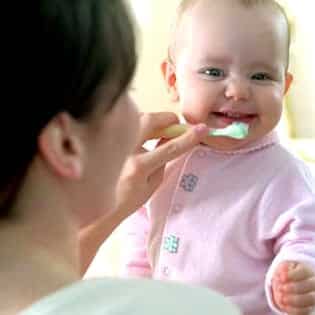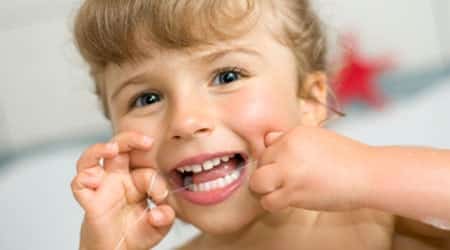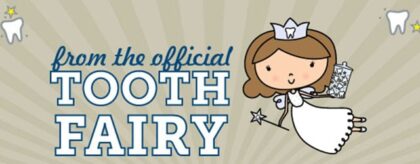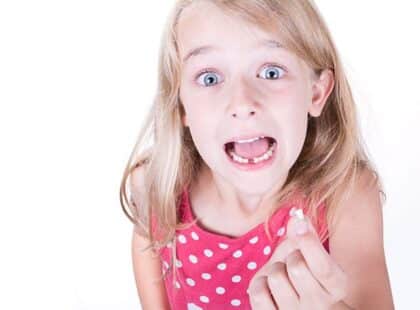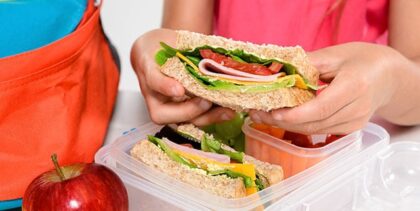Teaching Children Dental Care
When your child is young you are responsible for teaching your child everything. You teach him how to walk. You teach him how to talk. You teach him manners and basic etiquette. You teach him how to use “the big boy potty” and how to wash his hands. You teach your child about life. And he soaks it up because he has a curious mind and wants to know everything, just like you. One of your many teachings should include dental hygiene. It is your responsibility to instill good, healthy dental habits in your child.
When you should start teaching your child proper dental care?
Start your child’s dental care right away. Babies are born with all of their teeth, and they begin erupting between 6 – 9 months. But even before they begin cutting through the gums, you can make sure their mouths are clean by using a damp cloth or piece of gauze to wipe their gums after feedings. Once those chompers start cutting through you can start using a baby-sized toothbrush to break away the plaque that will start growing after their feedings. Once they are about a year old you can use the smallest smear of toothpaste on the bristles of their brush. But even at this age, it’s better for you to brush their teeth. At around age 2-3 you can start putting on a pea-sized amount of paste on the bristles. And around 2-3 years old, your child can start brushing his own teeth. You can start teaching your child about healthy dental habits early, but it will be better received when they can start brushing their own teeth.
What should you be teaching your children about proper dental care?
First, explain to your children why keeping their teeth clean and healthy is a good thing. Our teeth are tools. They help us chew food, which is the beginning of the digestion process. The hardest substance in the mouth, the teeth are responsible for cutting, tearing and grinding our food in preparation for swallowing. Teeth are also important for communication. Along with the lips and the tongue, teeth help people speak. The tongue and lips help to form words and the teeth control air flow, and the sound of the tongue hitting the teeth cause certain sounds to be created. It’s an intricate and complex process, but the end results are incredible.
You should also stress the dangers of not taking care of their teeth. Tooth decay and gum disease have been scientifically linked to heart disease, poor cardiac-health, diabetes, dementia and rheumatoid arthritis. Granted, most young children won’t understand these diseases, and won’t understand the full impact until they are much older, but acknowledging these dangers with your children can provide more insight into good dental health care. Now, using this information as a scare tactic to make your children brush their teeth twice a day is not really going to help your cause. Scare tactics, along with using a visit to the dentist as punishment, and bribery to get your child to brush and floss only hinder the process and can create a negative implication associated with good dental health. And can even cause certain dental phobias.
Second, teaching starts with good instructions. There really are specific techniques to brushing and flossing properly. If you aren’t sure you’re doing it right (in accordance to the American Dental Association guidelines for healthy gums and teeth) ask your hygienist the next time you go in for your regular check up. They love to show proper techniques! As a parent, you are the first person to teach your child to brush his teeth. Here are the basic, proper techniques in accordance with the ADA:
Brushing Techniques:
- Place your toothbrush at a 45-degree angle to the gums.
- Gently move the brush back and forth in short (tooth-wide), circular strokes.
- Brush the outer surfaces, the inner surfaces, and the chewing surfaces of the teeth.
- To clean the inside surfaces of the front teeth, tilt the brush vertically and make several up-and-down strokes.
- Brush your tongue to remove bacteria and keep your breath fresh.Of course, brushing your teeth is only a part of a complete oral care routine.
You should also make sure to:
- Clean between teeth daily with floss or an interdental cleaner. Tooth decay-causing bacteria still linger between teeth where toothbrush bristles can’t reach. This helps remove plaque and food particles from between the teeth and under the gum line.
- Eat a balanced diet and limit between-meal snacks.
- Visit your dentist regularly for professional cleanings and oral exam.
The instructions for teaching a child brushing
The best way to teach your child these instructions is by showing them these techniques. Start out by taking your toothbrush and putting the appropriate amount of paste on it. Be sure to let your child know his amount will be much less. Tell your child what you will be doing, then show him.
“I’m going to put the brush against my teeth at an angle, right against the gums, like this. See?”
Then brush a couple strokes.
“Then I’m going to brush in a short, tooth wide circular motion to be sure each tooth gets a good cleaning. See?”
Let them watch you brush your teeth, explaining, as well as you can, as you go. When it comes times to spit, explain why you are spitting out the paste.
“When we are done, or our mouth is just too full of bubbles and paste, we spit it into the sink. We do this because swallowing all that junk that just came off out teeth can make our stomachs upset.”
That’s probably the most a young child needs to know at first. When they get older, and understand more about things in general, you can explain to them about fluoride and toothpaste. Children under 5 should not use mouthwash at all. Under 12 they should be supervised. When you start teaching your child about flossing, make sure the verbal instructions go along with a visual explanation as well. Children learn better when they can see what they are supposed to do.
Instill good habits by using good habits.
Third, teach through good examples. From the moment a baby is born, they begin to watch and study the world around them. You’ve seen your little one mimic you when you stick your tongue out at him. They mimic your sounds, gestures and yes, even your habits. If your child watches you brush your teeth twice a day, every day, and floss every day, they will pick up the same habit.
Another way to instill these good habits is to make it a one-on-one or family event. Every morning, when your little one wakes up and is getting ready, get ready with him. Wash your faces together. Eat breakfast together. Brush your teeth together. This does three great things for your child. First, it’s another great opportunity for quality time with your little one. They grow up so fast and it’s important to find time to spend with them while they are developing and learning about their world and themselves. Second, it allows you to supervise your child’s brushing and flossing without being a hovering parent. It gives your child a sense of independence but still allows you to be there to help them when they need it and identify techniques which may require some correction. And lastly, watching your child brush and floss helps you to ensure you are doing the best job you can. If you notice your child’s technique requires a bit of tweeking, perhaps yours does too. As a parent you lead by example. And brushing your teeth with your child allows you to take a closer look at the example you are setting.
How does food affect your children’s teeth?
Nutrition is always an important part of your child’s development including dental and oral health development, however, sugars and acids are harmful to teeth–what a conundrum! You have to eat to get strong and stay healthy, but almost all foods hold some amount of sugar or acid, which can cause tooth decay. Foods such as vegetables, milk, juice, fruit, meat and even grains have sugars or acids in them.
So what does a parent do? Monitor your children’s food. Junk food should be limited heavily. It’s just not healthy. And it contains the most amount of sugar and acid. If a child’s diet consists mainly of junk food (fast food like McDonalds, Burger King, Taco Bell and Arby’s, or snacks like chips, cookies, cakes, brownies, candies, etc.) not only will it contribute to childhood obesity, but also create many dental health problems including severe tooth decay. Also, if the child’s tummy is full of junk food there is no room for the good sugars and acids. Vegetables and fruits do contain a variety of nutrients for our children, including good sugars and acids–the kind our bodies can actually use, regulate, digest and need to keep up energy. But those sugars and acids can still be dangerous to our teeth in high amounts.
The best thing for our children to do to avoid tooth decay is to maintain proper dental care–brush and floss after each meal. Granted, children can’t always find time during the school day to brush their teeth after lunch. And that’s fine. But then they should wash down those healthy lunches and snacks with water. Not soda. Not juice. Not sport’s drinks. Those all contain A LOT of sugar AND acid. Water should be the lunch beverage of choice, but milk is an acceptable alternative. In the mornings, have your children brush their teeth AFTER breakfast, and in the evenings after dinner. If your child will only floss once a day (or let’s be realistic once every couple of days) have them floss at night. This way the build up from the day isn’t sitting there overnight.
Keep these concepts in mind when you start teaching your children about eating healthy.
Moderation is always key in a healthy diet. It is not always necessary to cut out sweets and sodas all together, and let’s face it, with how readily available these snacks are, it may not be realistic for children. But maintaining moderation in the consumption of these snacks and drinks is key. Substitute candy bars for veggies and fruit. Start early in a child’s exploration of foods by using sweeter fruits as treats instead of candy. Healthy snack foods include sliced raw veggies, fresh cheeses (not highly processed Velveta), nuts or yogurt. Healthy drink options are water and limited amounts of milk. Juice is good for children, but it’s not good for sipping. If your child enjoys juice, water it down and make sure he doesn’t spend an excessive amount of time just sipping it. There are sugar substitutes (chemical sweeteners), found in “diet” drinks and foods so avoid these. These may not contribute to tooth decay-causing bacteria, but they are also much hard for a child’s system to digest. (Truth be told they are difficult for adults to digest as well).
Proper dental care is essential for a healthy, happy child. As a parent, it is your responsibility to teach your child how to care for his or her teeth. With so much going on in your child’s development, it is important to recognize their needs and help them advance in positive ways. Teaching your child how to brush and floss, and explaining why these are necessary will help your child maintain healthy habits. Remember to lead by example. Your child will always look up to you and if you keep your smile healthy, your child will keep his smile healthy as well. Talk to your dentist about the appropriate time to start scheduling your child for his regular check-up and cleaning. Consider taking your child to see a pediatric dentist, who would specialize in dental care for children. For more information on pediatric dentistry, check out next week’s blog!
